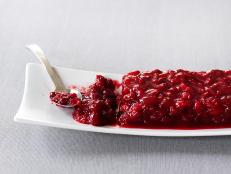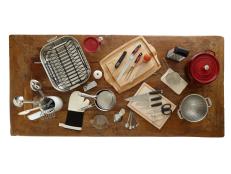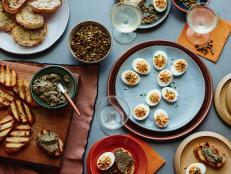Back in Time for Thanksgiving
On Cooking Channel's "Back in Time for Thanksgiving," join host Simon Majumdar, comics Sasheer Zamata and John Murray on a culinary journey through the dishes that kicked off America's favorite food tradition.
Related To:
Travel Back to September 1620
New England is known today for bucolic autumns, fantastic seafood and high-end vacation destinations like Cape Cod. It wasn't always such an idyllic spot.
Pilgrim Problems
After a months-long trek across the Atlantic, the Pilgrims arrived on the chilly coast with winter around the corner. If you've ever spent a winter in New England, you know it's nothing to laugh at.
Flexing Their Mussels
They weren't experienced fishermen, but they found the coast fortunately abundant with mussels and lobster.
Shipwrecked
They tried eating the mussels but most of them got sick. Some spent winter on the Mayflower while others roughed it onshore. Half died of disease or exposure.
Four Months Later
In the spring, they were finally able to venture onshore, but only half of the Mayflower's original 102 passengers remained. Still, most of the crops they planted didn't take.
Friendly Neighbors
Things were looking bleak, but they found allies in their new neighbors, the Wampanoag, who taught them a special method of fishing ... for corn.
New World Diets
Armed with their new knowledge of fertilization, the Pilgrims were able to grow turnips, cabbage, parsnips, onions, carrots, parsley and sage and use them to make a variety of stews.
Pilgrim Party
There was a tradition they intended to bring over from the Motherland: the Harvest Festival, a major celebration in Britain at the time.
Venison Value
They were used to eating "Humble Pie" made of the "umbles," or innards of deer, but now they could eat choice venison steaks. But much of the staples of the modern feast weren't there. They didn't have sugar or butter or apples or even (gasp) marshmallows.
Corn-ucopia
There was a plethora of multicolored corn that they parched (roasted the cob on hot coals until the kernels were cooked) or ground into corn meal to make breads (like this cornbread).
The Feast
After a particularly well-earned harvest, 53 Pilgrims sat down at tables with 92 of their Native American neighbors to partake in a feast they could never have imagined a year earlier.
Past Provisions
Though there were no white potatoes (those existed only in South America) for mashing, no cranberry sauce (that wouldn't be invented for almost 300 years) and no forks (those weren't popular in America until the Revolutionary War), the feast was the party of the century and laid the groundwork for a tradition that is carried on today.
November 24 at 5pm ET
Tune in to Back in Time for Thanksgiving to find out more about the history and food that marked the beginning of an American tradition.














